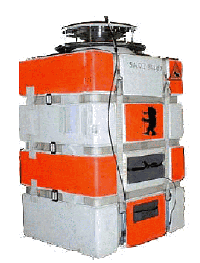Purpose of the flight and payload description
SAOZ is an UV-visible spectrometer able to provide vertical profiles of O3, NO2, OClO, BrO and H2O by solar occultation during ascent of the balloon (or descent) and from float at 30 km during sunset (or sunrise). The balloon version of the SAOZ instrument is very similar to the one used for ground-based measurements of total ozone and NO2.
It is composed by a commercial flat field, 360mm, holographic grating spectrometer equipped with a 1024-diode linear array and an entrance slit of 50 µm. A simple conical mirror replaces the gondola orientation or sun tracker systems generally used on large balloon platforms and is driven by an on-board computer, connected to a PTU (Pressure, Temperature and Humidity) sensor, a GPS (Global Positioning system ) for the localisation (Altitude, latitude and longitude) and an Argos transmitter for the recovery of the payload after cut-down and descent under parachute.
At left can be seen a picture of the standard package (click to enlarge).The weight of the instrument is 20 Kg and is contained in a insulated box with only a small aperture in the top for capture the solar rays. It's currently flown in three configurations, SaOZ-Standard, SAOZ-BrO and SAOZ-H2O each tuned to a different wavelength for measurements of different atmospheric constituents.
Also was flown under the same balloon an instrument called DESCARTES (Détermination Et Séparation par Chromatographie lors de l'Analyse des Résultats des Traceurs Échantillonés dans la Stratosphère) created for the measurement of long-lived trace gases (CFC-11, CFC-113, CCl4 and CH3CCl3) in the stratosphere by the University of Cambridge. The low weight of less than 20 kg and no need for telemetry make the instrument suitable for being launched on small balloons or fly as piggyback on larger balloons.
The working principle is to let an amount of air pass through 16 sample tubes containing a Carboxen adsorbent. A valve allows only one tube at a time to be exposed to the air flow. Trace gases will then be trapped inside the sample tubes while the rest passes through.
An on-board computer controls the sampling sequence, and also measures the flow of air, the pressure and temperature, the level of the batteries, and the state and position of the valve.
After the flight, the data is downloaded from the computer, the sample sizes are determined and the sample box is connected to a gas chromatograph for quantification.
Details of the balloon flight
Balloon launched on: 12/2/1998 at 14:40
Launch site: Centre de Lancement de Ballons CLBA, Aire Sur L'Adour, Landes, France
Balloon launched by: Centre National d'Etudes Spatiales (CNES)
Balloon manufacturer/size/composition: Zero Pressure Balloon model 10zl Zodiac - 10.000 m3
Balloon serial number: 10ZL Nº 81
End of flight (L for landing time, W for last contact, otherwise termination time): 12/2/1998 at ~ 17:45
Balloon flight duration (F: time at float only, otherwise total flight time in d:days / h:hours or m:minutes - ): 3 h 6 m
Payload weight: 96 kgs
Gondola weight: 57 kgs
External references
- Climatology of the stratospheric BrO vertical distribution by balloon-borne UV-visible spectrometry Journal of Geophysical Research (Atmospheres), Volume 107, Issue D24, pp. ACH 23-1
135If you consider this website interesting or useful, you can help me to keep it up and running with a small donation to cover the operational costs. Just the equivalent of the price of a cup of coffee helps a lot.


